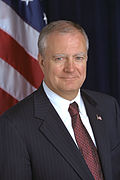| Science Advisor to the President | |
|---|---|
| Office of Science and Technology Policy | |
| Reports to | President of the United States |
| Appointer | The president with advice and consent by the Senate |
| Term length | No fixed term |
| Precursor | Chair of the Science Advisory Board |
| Formation | June 28, 1941 |
| First holder | Vannevar Bush |
| Officially: Director of the Office of Science and Technology Policy. Historically: Director of the Office of Science and Technology, Chairman of the President's Science Advisory Committee, Director of the Office of Scientific Research and Development | |
The science advisor to the president is an individual charged with providing advisory opinions and analysis on science and technology matters to the president of the United States. The first science advisor, Vannevar Bush, chairman of the Office of Scientific Research and Development, served presidents Franklin Delano Roosevelt and Harry S. Truman from 1941 to 1951. President Truman created the President's Science Advisory Committee in 1951, establishing the chairman of this committee as the president's science advisor. This committee continued under presidents Dwight D. Eisenhower, John F. Kennedy, Lyndon B. Johnson, and Richard M. Nixon until 1973. Nixon terminated the committee rather than appointing a replacement for his advisor who had resigned. The US Congress established the Office of Science and Technology Policy in 1976, re-establishing presidential science advisors to the present day.
Contents
The current advisor is Michael Kratsios, who is serving as the 13th director of the White House Office of Science and Technology Policy (OSTP) since 2025. [1]



























